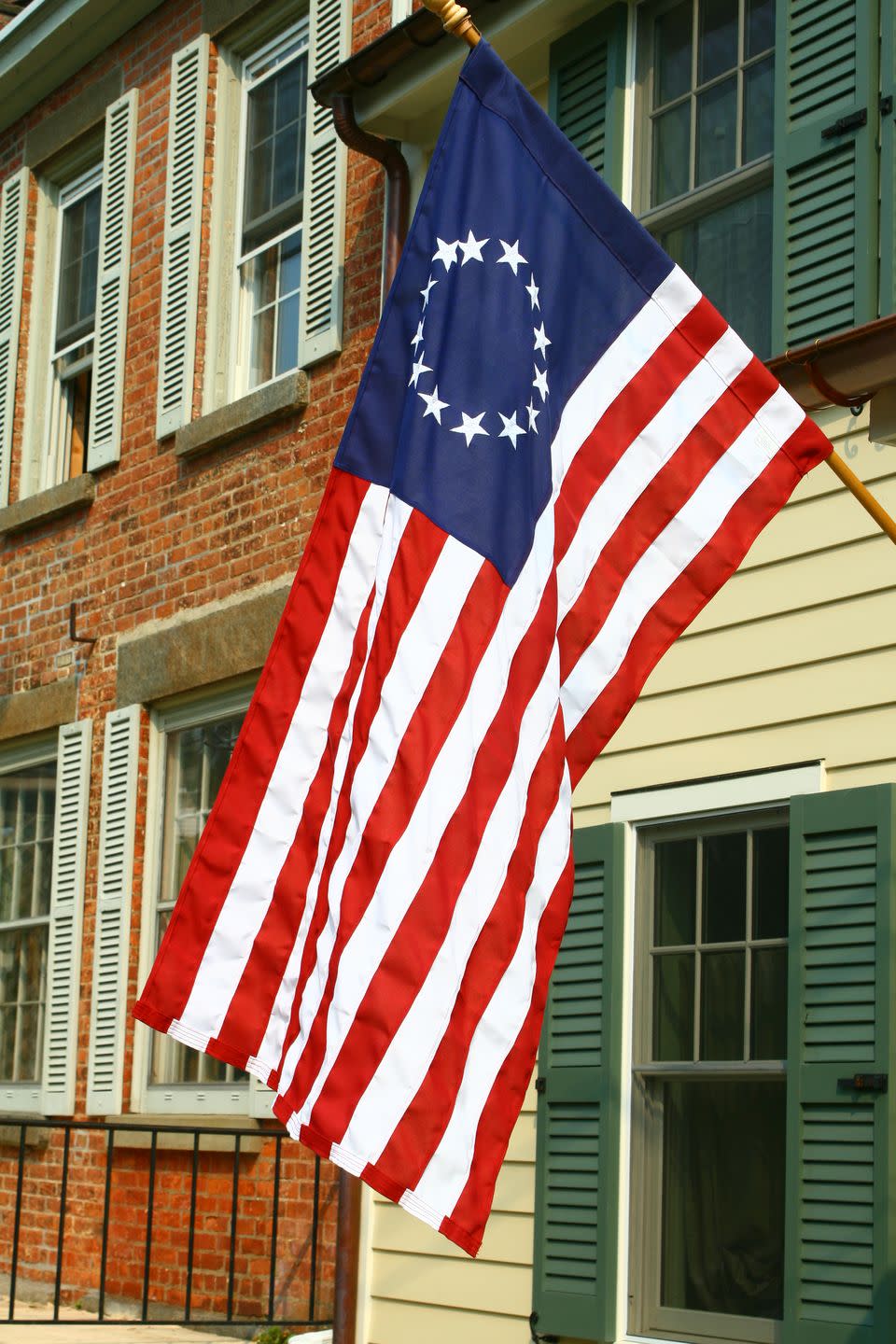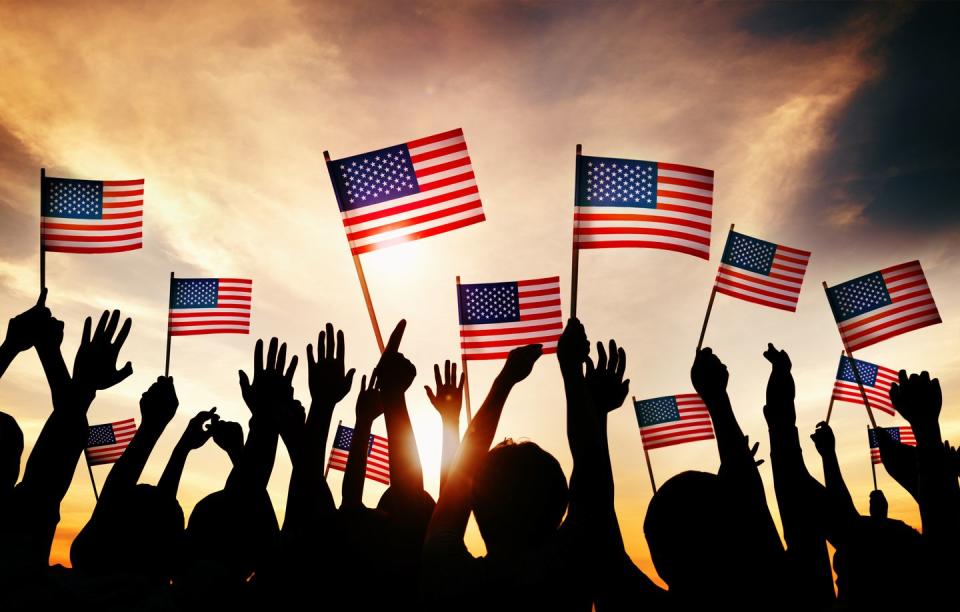Check Out These Cool and Patriotic Facts About the American Flag

"Hearst Magazines and Yahoo may earn commission or revenue on some items through these links."
When you think of the USA, one of the first things that comes to mind is probably the American Flag. It's the symbol of this nation, which is essentially why you see it waving over school buildings and other official state houses throughout the country. Though, do you know the exact significance behind those stars and stripes? There's plenty of history behind the flag that you ought to know about! In turn, there is proper etiquette and folding rules that come along with it—so it's really worth taking a deep dive into everything you need to know about the American Flag. With that said, keep reading for some fun and interesting American Flag facts.
Folks across the nation will observe Memorial Day this May, and Flag Day follows shortly after on June 14. This later holiday is often forgotten among the other patriotic summer celebrations, but it's important to honor the banner that represents the history of our beloved country. To celebrate, you can fly Old Glory in front of your home or business.
And read on here for all those cool facts. You can either wow your friends and family with them in casual conversation, or create a fun quiz to see who knows their stuff. The winner gets the first slice of flag cake!
There is an American flag so large that it's called the Superflag.
Anytime you see a large American flag at a major event, there is a good chance that it is a Superflag. The company of that same name is responsible for creating large flags that usually take hundreds of people to carry and present—which in turn makes for one awe-inspiring experience!
The American flag is displayed backward on military uniforms.
This is done for a reason! A kind of meaningful and chill-inducing one, too. It's so that the star field will always face front as a means to mimic a flag waving in the wind as military personnel charge into battle.
There is an American flag on Mount Everest!
You can thank Barry Bishop for that. He made the trek up the intimidatingly beautiful mountain in 1963, sticking the patriotic flag up on the top of it. How cool is that? (He also took the flag of the National Geographic Society with him, too.)
The flag did not always have 50 stars and 13 stripes.
It's safe to say that most Americans know that the flag hanging in their home has 50 stars representing the 50 U.S. states. You probably also know that it has 13 stripes, but the reason why is a little less self-evident.

The flag we fly today is not how it appeared two centuries ago. The original flag, created in 1776, was designed with 13 stars and 13 stripes to represent the 13 American colonies. Since then, there have been 27 versions of the American flag, according to the National Flag Foundation.
Betsy Ross designed the first flag—or did she?
Philadelphia seamstress Betsy Ross is widely believed to have stitched the first-ever American flag after making changes to an initial design. However, historians have never been able to verify that completely, according to History.com. The first flag was adopted by Congress in 1777, but the story about Betsy first came to light almost a hundred years later when William Canby, her grandson, held a press conference claiming his grandmother made the flag at George Washington’s request. To this day, there is still no credible historical evidence that can verify William's claim.
The current flag was designed by a high school student.

Teenagers are far more capable than we give them credit for! But seriously, who knew the 50-state American flag was designed by a teen?! In 1958, there was a contest to come up with a new flag that represented how the country had grown. Then-17-year-old Robert G. Heft of Lancaster, Ohio, submitted a design to the contest, which President Dwight Eisenhower chose from over 1,500 other submissions.
The colors on the flag are meaningful.
Many people may not know that the colors on the American flag weren't just an aesthetic choice—they actually mean something! According to USA Gov, here's what the colors on our flag represent: red represents valor and bravery; white represents purity and innocence; and blue represents vigilance, perseverance, and justice.
You can order a flag that has flown over the Capitol.
Yep, you read that right! You can really own a flag that has flown over the U.S. Capitol building. Here's how you do it: You'll have to contact your state senator, so make sure you know who to reach out to. Luckily, there's a Senate Directory. After you find your senator, head to their website and find the constituent services webpage. There, you can find a "Flag Requests" form. Just follow the specific ordering instructions provided by your state senator and soon you can have a Capitol flag of your own. So cool!
The American flag is flown at half-staff during times of mourning.
After a tragedy or death in the U.S., the flag should be flown at half-staff. This to honor the lives of those lost. According to the U.S. Department of Veteran Affairs, to properly fly the flag at half-staff, it should briskly run to the top of the staff before being lowered slowly to half-staff. This position is called "half-staff" on land, but "half-mast" on a ship.
The flag actually can be displayed for 24 hours a day—but there's a catch.
Federal law states that the flag should be displayed only between sunrise and sunset. However, you can display the flag for all 24 hours if you use lighting to ensure that it can be seen in the dark, the National Flag Foundation says.
Flags should be "destroyed in a dignified way."
Although many consider burning the flag a sign of disrespect, that's not always the case. In fact, the National Flag Foundation notes that this is actually the preferred way to dispose of an American flag that is damaged or worn beyond repair. The U.S. Flag Code says, "The flag, when it is in such condition that it is no longer a fitting emblem for display, should be destroyed in a dignified way, preferably by burning."
The flag should never touch the ground.

According to U.S. Code, you should never let the flag touch the ground or water. The flag is often flown at half-staff during periods of mourning or national days of remembrance. A few other notable rules say you should never: display a flag upside down (except during times of dire distress or danger); carry it flat or horizontally; or use it as wearing apparel, bedding, or drapery.
A flag that has touched the ground can still be used.
You shouldn't let a flag touch the ground if you can help it. But if it does touch the ground, it can still be displayed—after it's washed or dry cleaned.
Six American flags have been planted on the moon.

The image of Buzz Aldrin on the moon with an American flag is one of the most iconic photos in American history. The U.S. planted the first flag on the moon during the Apollo 11 mission in 1969. Since then, five more U.S. flags have been planted on the moon during subsequent missions.
What is Flag Day anyways?
Every June 14 in the United States, we celebrate Flag Day. But do you know why? It's because on that date in 1777, the Second Continental Congress officially adopted the American flag as America's national symbol. This year, for Flag Day 2024, you'll know exactly why you're celebrating—and you can impress your friends and family with these 15 fun facts about the American flag!
You Might Also Like

